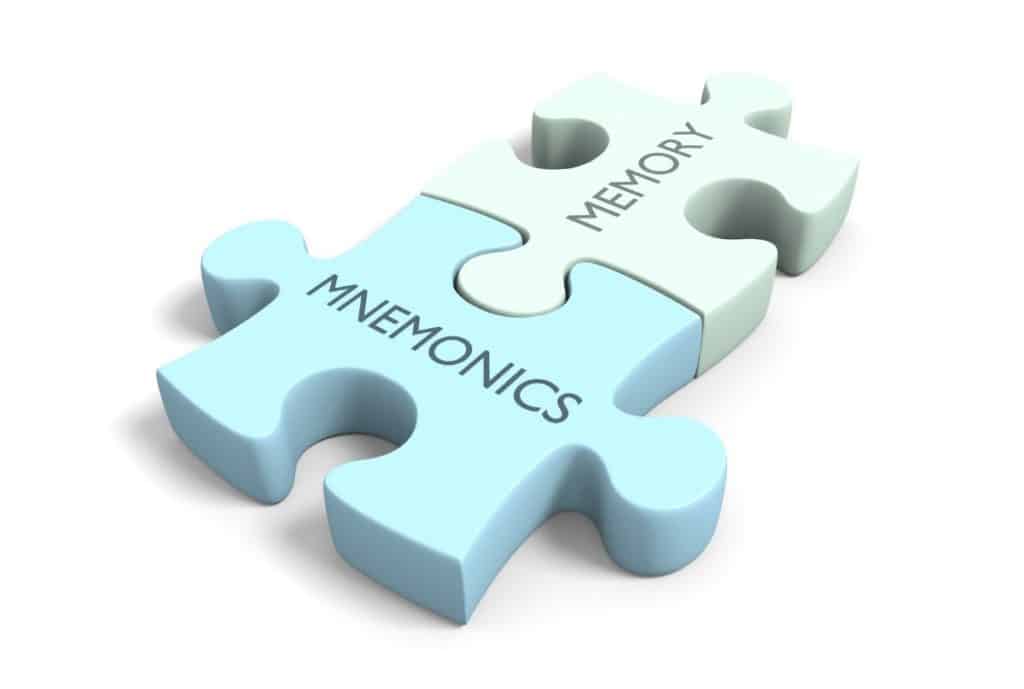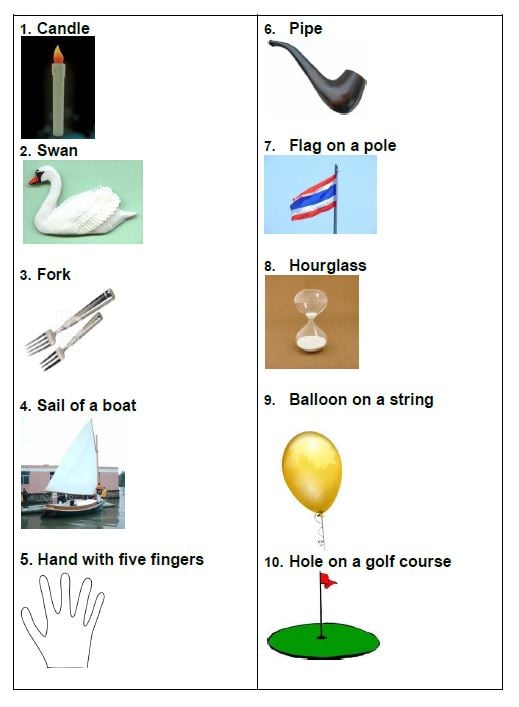

There are various mnemonic techniques, including the method of loci, pegwords, acronyms, acrostics, spelling mnemonics, and number-sound mnemonics.
The method of loci, also known as the memory palace technique or the journey method, is probably the most versatile mnemonic filing system ever devised. Memory performers use it on stage to memorize 100-digit numbers and the order of several complete decks of cards. Students use it to pass exams, and salespeople to give a presentation from memory.
People who have never used it just cannot believe how someone can have such a fantastic memory. The good news: It is really easy to learn.
The word ‘loci’, commonly pronounced as ‘LOW sigh,’ comes from the Latin word meaning place or location. The loci mnemonic system uses locations as memory aids. It is an old mnemonic link technique dating back to around the year 500 BC (yes, that’s more than 2500 years old!). This technique involves associating items that you must remember with places well known to you, such as your house, neighborhood, work place, or body parts.
Devised during the days of the Roman Empire, the method of loci is really a sort of linking method with a twist. According to Cicero, this method was developed by the poet Simonides of Ceos, who was the only survivor of a building collapse during a dinner he attended.
Simonides could identify the dead, crushed beyond recognition, by remembering where the guests had been sitting. From this experience, he realized that it would be possible to remember anything by associating it with a mental image of a location.
The loci system was used as a memory tool by Greek and Roman orators, who took advantage of the technique to give speeches without notes. It was the most popular mnemonic system until about the mid-1600s when number-sound mnemonics and peg systems were introduced.
To use the loci system, you must first memorize a series of images of familiar locations in a natural, logical order. It is easiest to choose a location you are already familiar with and decide on an order you will use. This set of images is used each time you use the loci system. What images you choose isn’t important as long as you can visualize them clearly and recall them easily.
You can further increase the number of locations by using different parts of each place — for example, the living room may be considered one place. It may be further divided into things you find in your living room such as a TV, a window, a door, and a couch, each of which can be used as a location in your system. However, make sure you can recall each location as being distinct from the others.
Suppose you want to memorize the following list:
Assume that your set of locations is those of your house. You would start by imagining yourself entering the house. After the front door, you imagine seeing a dog that wiggles its tail and barks. Walking toward the hallway, you see stars on the roof ― blinking as if you were outside watching the sky. And as you turn to the kitchen, on the kitchen table, you find a pumpkin with the number 5 carved into it. Next, you imagine yourself shouting from the kitchen window: “How ORIGINAL!”
To recall the list, you imagine yourself going through the locations ― in other words, taking a route ― from the outer door to the hallway to the kitchen. As you go through the places, you will recall the dog, stars, et cetera, and can thus reconstruct the originally memorized material.
While you memorize the list by doing the associations to locations, you can easily test yourself on your progress by going through the route until you can remember all the items in sequence. Testing yourself is an essential part of the method ― you need to overlearn, and therefore you will likely not memorize the entire list with just one walk-through attempt.
Need help remembering lists of information for school, work, a hobby, or other purposes? Then the peg system is what you need.
The idea behind the peg system has been traced to the mid-1600s when Henry Herdson developed it. Herdson linked a digit with any one of several objects that resembled the number (for example, “1 is candle”). The system gets its name from the fact that the pegwords act as mental “pegs” on which you can hang the information you need to remember.
Number-shaped pegs connect shapes to numbers (see below). So, to associate an item of information with a number shape, associate the shape with the information. For example, to associate a word such as “tomato” to position number two in the list, associate swan with tomato. Imagine a swan bouncing a bright red tomato up and down on its beak. Then, when you think of “two,” it reminds you of “swan,” which reminds you of a tomato.

An acronym is a word made up by taking the first letter from each word you want to remember and making a new word from all those letters. For example, if you want to remember the names of the Great Lakes of North America, you could learn the acronym HOMES — Huron, Ontario, Michigan, Erie, Superior. Below are several more examples:
BEDMAS: Brackets, Exponents, Division, Multiplication, Addition, Subtraction — Sequence in which you should tackle any math problem with multiple calculations.
BRASS: Breath, Relax, Aim, Sight, Squeeze — How to shoot a rifle.
FACE: The letters of the treble clef notes in the spaces from bottom to top spells “FACE”.
FAN BOYS: Use a comma between two independent clauses separated by one of the “FAN BOYS” (For, And, Nor, But, Or, Yet, So).
FOIL: F stands for first terms; O stands for outer terms; I stands for inner terms, and L stands for last terms. — The steps involved in factoring algebra problems.
IPMAT: Interphase, Prophase, Metaphase, Anaphase, Telophase — The stages of cell division.
MET DR THIP: Mimas, Enceladus, Tethys, Dione, Rhea, Titan, Hyperion, Iapetus, and Phoebe — Saturn’s moons
NEWS: North, East, West, South — The points of the compass.
PEN: Proton, Electron, Neutron — The parts of an atom.
ROY G. BIV: Red, Orange, Yellow, Green, Blue, Indigo, Violet — Colors of the spectrum.
STAB: Soprano, Tenor, Alto, and Bass — Four voices in a quartet.
Acrostics support recall by creating an entire sentence with the first letter of each word being the prompt for the to-be-recalled information. For example, the planets in the order from the sun correspond to the first letter of each word in the sentence, “My very educated mother just sent us nine pizzas.” Below are several more examples:
Blood’s functions:
Old Charlie Foster Hates Women Having Dull Clothes
Oxygen (transport), carbon dioxide (transport), food, heat, waste, hormones, disease, clotting
Bones of the skull:
Old People From Texas Eat Spiders
Occipital, parietal, frontal, temporal, ethmoid, sphenoid
British rank order below Kings and Queens:
Do Men Ever Visit Britain?
Duke, Marquis, Earl, Viscount, Baron
Continents:
Eat An Aspirin After A Nighttime Snack (NOTE: The 2nd letter in the first three “A” words help to remember the “A” continents)
Europe, Antarctica, Asia, Africa, Australia, North America, South America
Cranial nerves:
On Old Olympus Towering Tops, A Finn And German Viewed Some Hops
Olfactory, optic, oculomotor, trochlear, trigeminal, abducens, facial, acoustic, glossopharyngeal, vagus, spinal accessory, hypoglossal
Cranial nerves (function):
(1st letter) S=sensory, M=motor, B=both
Some Say Marry Money But My Brother Says Bad Boys Marry Money
Directions of the compass:
Never Eat Sour Watermelons
North, East, South, West
Geological ages:
Practically Every Old Man Plays Poker Regularly
Paleocene, Eocene, Oligocene, Miocene, Pliocene, Pleistocene, Recent
Great Lakes in order of size:
Sam’s Horse Must Eat Oats
Superior, Huron, Michigan, Erie, Ontario
Guitar strings:
Eat All Dead Gophers Before Easter
E, A, D, G, B, E
Jupiter’s moons:
An Icecube Ever Grows Colder
Amalthea, Io, Europa, Ganymede, Callisto
Oceans:
I Am A Person
Indian, Arctic, Atlantic, Pacific
Metric system in order:
King Henry Drinks Much Dark Chocolate Milk
Kilometer, hectometer, decameter, meter, decimeter, centimeter, millimeter
Neptune’s moons:
Neptune’s Tiny Dancing Girls Look Pretty To-Night
Naiad, Thalassa, Despina , Galatea, Larissa , Proteus, Triton, Nereid
New Testament order:
General Electric Power Company
Galatians, Ephesians, Philippians, Colossians
Rainbow colors:
Richard Of York Got Bugged In Venice
Red, orange, yellow, green, blue, indigo, violet
Taxonomic classification system of living organisms:
King Philip Can Only Find his Green Slippers
Kingdom, Phylum, Class, Order, Family, Genus, Species
Taxonomic classification for humans:
Anthropology Can Make People Hate Helping the Sick
Animalia, Chordata, Mammalia, Primates, Hominidae, Homo Sapiens
Seven deadly sins:
All Private College Leave Serious Educational Gaps
Anger, pride, covetousness, lust, sloth, envy, greed
Seven Wonders of the Ancient World:
Seems Like MataHari Picked Her Targets Carefully
Statue of Zeus at Olympia, Lighthouse of Alexandria, Mausoleum at Halicarnassus, Pyramid of Giza, Hanging Gardens of Babylon, Temple of Artemis at Ephesus, Colossus of Rhodes
Zodiac constellations:
As The Great Cook Likes Very Little Salt, She Compensates Adding Pepper
Aries, Taurus, Gemini, Cancer, Leo, Virgo, Libra, Scorpio, Sagittarius, Capricorn, Aquarius, Pisces
Spelling mnemonics are intended to help us remember the spelling of words. In order to remember that the word “cemetery” is spelled with three e’s, for example, one can picture a lady screaming ‘e-e-e’ as she walks past the cemetery. Below are several more examples: